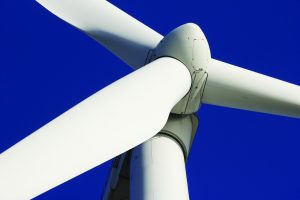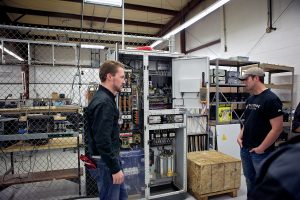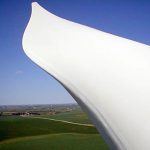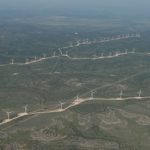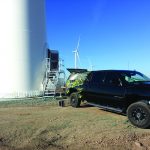The days of mind-numbing hours reviewing hundreds, even thousands of wind-blade pictures to find the areas of damage, and classifying that damage, are soon to be going the way of corded telephones. Like that 20th-century relic, technological advancement has brought opportunities to create more efficient ways of conducting business. Advancement in robotics, image capture, data creation and management, and deep-learning artificial intelligence algorithms have created a new world of possibilities.
These technologies will be game changing in many industries, and wind energy is no exception. Images can be captured in multiple methods, but the real value is in leveraging the data produced in a way that efficiently solves business problems. Inspections by unmanned aerial systems (UAS, commonly called drones), robotic arms, or high-resolution spotting scopes are becoming more common every day — and they’re proving effective. The real answers, however, lie within the data. How to best compute that data and consume that data?
It’s been a productive year for the team at EdgeData. It entered the wind industry a rookie in 2016 with new ideas to improve wind-turbine inspections through deeper insight from raw data. After a year’s worth of experience under their belts, the software is getting smarter. EdgeData isn’t just a drone-flying company that captures images of critical utility infrastructure. During aerial blade inspections, it delivers high-quality images and metadata with BladeEdgeSM, its patent-pending software solution.
Deep-learning technology recognizes and classifies damage, pinpointing the exact area needing attention at an entire blade and individual image level. Given time, the proprietary BladeEdge analytic software will track trends in wear and damage, and it can help operators determine proactive plans to develop budgets, maximize infrastructure lifecycles, minimize energy loss due to poor blade conditions, and proactively manage repairs to increase return on repair investments.
EdgeData operates under three process pillars: capture, compute, and consume. And it’s not doing it alone. It has cultivated partnerships with industry leading organizations training the next generation of wind-turbine technicians and inspectors to capture data “the BladeEdge way.” They’re changing the wind-inspection game — at a foundational level.

Capture
Wind-turbine inspections with UAS are still new, and EdgeData is working to define the standard for flight procedures. The work to capture the correct data, the correct way is the first step. Earlier this year, Oak Ridge National Laboratory enlisted EdgeData’s advice on flight operations procedures and processes for flying near wind infrastructure. As the largest U.S. Department of Energy science and energy laboratory in the United States, Oak Ridge National Laboratory delivers transformative solutions to the challenges facing the energy and related security industries.
“We were honored to contribute to Oak Ridge National Laboratory’s work,” said Josh Riedy, COO at EdgeData. “Together, we’re setting the standard for high-quality inspections across all industries, ensuring safety and productivity above all else.”
EdgeData’s UAS operator and team shared their flight operation procedures for wind infrastructure inspection via drone. An Early Survey of Best Practices for the Use of Small Unmanned Aerial Systems by the Electric Utility Industry was published in February, and it is regarded as a top resource for UAS specialization in the utility and energy industries.
Efficiency in the Field
The software is only effective when high-quality raw data is correctly captured. With the UAS industry being so young and having many variables in the field, developing a means of capturing accurate data was essential.
EdgeData’s BladeEdge Capture Assistance Tool (BECATSM) was designed specifically for use in the field and ensures every drone always captures quality imagery. After completing an inspection flight, pilots can verify the data on a laptop, double-checking to be sure no square inch is left uninspected. With BECAT, EdgeData has taken a large step toward automated flight assistance. Whatever the inspectors’ level of flying expertise, they’ll be able to leave the field with the data needed to provide a quality inspection.
The tool also packages the imagery and all necessary meta-data for processing by BladeEdge’s deep learning analysis algorithms. This saves time, and it can eliminate the possibility for human error. That means owners and operators have a complete, high-resolution close-up image of their infrastructure and do not need to spend hours reviewing each image. The anomalies have automatically been identified, located, and classified.
The BladeEdge software leverages deep learning technology to complete an automated assessment of the imagery captured in the field. Capturing overlap and pixel spacing in the field allows images to be stitched together into a single mosaic. This mosaic is color coordinated to highlight any damage or areas of concern. With each damaged area, the machine gets smarter and applies that knowledge to future inspections. This is the deep-learning layer of artificial intelligence.
Over time, owners and operators will be able to track wear patterns on blades and develop proactive maintenance plans to maximize the life of their infrastructure and increase annual energy production.

The Next Generation of Inspectors
EdgeData also is looking at the future of the wind turbine blade inspection industry. In partnership with North Dakota’s Lake Region State College (LRSC) in Devil’s Lake, North Dakota, EdgeData is working to develop the next generation of wind-turbine inspectors.
LRSC’s Wind Energy Technician Program is an associate in applied science degree, the first of its kind. The inaugural class graduates in May as aerial inspection enabled wind techs. Students have been learning in a hands-on environment, gaining real-world maintenance and repair experience on actual wind turbines.
The program now includes UAS curriculum, thanks to EdgeData, and students are working toward remote pilot certification under FAA regulations Part 107. Part of their coursework will include training on both BECAT flight procedures and the BladeEdge software. Graduates will be primed for jobs as inspectors in the wind-energy field. To date, the program has seen nearly 100 percent job placement for graduates.
Compute: Maximizing Deep Learning
With the training of new wind technicians in the hands of LRSC and a network of partners and technology bringing flight-assist software, EdgeData can focus on software, big data, and deep learning technology that produce a top-quality inspection more easily and efficiently than ever before. Each time data is collected, it further trains the software to recognize damage and anomaly areas on future inspections.
Not all flying conditions are created equal. In a perfect world, UAS inspections would be conducted on bright, sunny days. But in reality, the weather doesn’t always cooperate. BladeEdge was developed with tolerance for hazy or gloomy days and is effective in capturing blades against a gray sky. Even in poor conditions, pilots can capture complete image sets, delivering the data operators need to maintain their infrastructure.

UAS Specific Data Storage
As EdgeData continues to grow, so does its need for data storage. All the big data must be processed and stored somewhere. The preference is that this data be stored near the processing points to minimize the need for transport of massive data sets. EdgeData has ambitions to create an environment custom-designed for the image treatment and machine learning algorithms critical to EdgeData and others in the drone image capture business.
EdgeData recently announced its intent to establish a 16,000-square-foot data center facility at Grand Sky, a UAS Business and Aviation Park in Grand Forks, North Dakota. Grand Sky is a highly secure, UAS specific environment and is ideal for a data center. The new facility will allow EdgeData to host an optimized environment for operations.
Consume
What does this all mean for the wind industry? It means manufacturers, owners, operators, and third-party service providers will have access to better data. With better data and complete imaging of their wind-turbine blades, they can make educated decisions for proactive maintenance and repair of damage. They’ll maximize energy output while negating potential losses.
The entire methodology EdgeData has pioneered validates the importance of strong partner relationships that serve the industry as a whole. Capturing more data allows for longitudinal comparison of damages. Years of compiled data will show how wind-turbine blades degrade over time. It will track the impact of various climates on performance. The top causes of damage or wear will be identified. When raw data is turned into actionable intelligence, the value of this is only limited by our imaginations in how to apply what is learned.

















